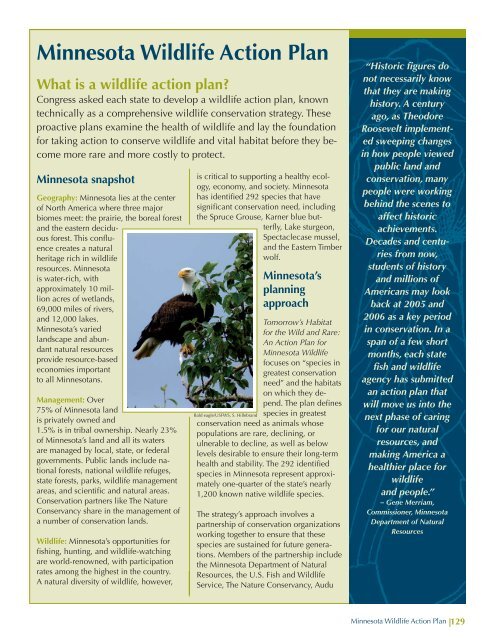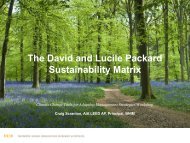State WAP Revised 8.29.06.indd - Teaming With Wildlife
State WAP Revised 8.29.06.indd - Teaming With Wildlife
State WAP Revised 8.29.06.indd - Teaming With Wildlife
Create successful ePaper yourself
Turn your PDF publications into a flip-book with our unique Google optimized e-Paper software.
Minnesota <strong>Wildlife</strong> Action Plan<br />
What is a wildlife action plan<br />
Congress asked each state to develop a wildlife action plan, known<br />
technically as a comprehensive wildlife conservation strategy. These<br />
proactive plans examine the health of wildlife and lay the foundation<br />
for taking action to conserve wildlife and vital habitat before they become<br />
more rare and more costly to protect.<br />
Minnesota snapshot<br />
Geography: Minnesota lies at the center<br />
of North America where three major<br />
biomes meet: the prairie, the boreal forest<br />
and the eastern deciduous<br />
forest. This confluence<br />
creates a natural<br />
heritage rich in wildlife<br />
resources. Minnesota<br />
is water-rich, with<br />
approximately 10 million<br />
acres of wetlands,<br />
69,000 miles of rivers,<br />
and 12,000 lakes.<br />
Minnesota’s varied<br />
landscape and abundant<br />
natural resources<br />
provide resource-based<br />
economies important<br />
to all Minnesotans.<br />
Management: Over<br />
75% of Minnesota land<br />
is privately owned and<br />
1.5% is in tribal ownership. Nearly 23%<br />
of Minnesota’s land and all its waters<br />
are managed by local, state, or federal<br />
governments. Public lands include national<br />
forests, national wildlife refuges,<br />
state forests, parks, wildlife management<br />
areas, and scientific and natural areas.<br />
Conservation partners like The Nature<br />
Conservancy share in the management of<br />
a number of conservation lands.<br />
<strong>Wildlife</strong>: Minnesota’s opportunities for<br />
fishing, hunting, and wildlife-watching<br />
are world-renowned, with participation<br />
rates among the highest in the country.<br />
A natural diversity of wildlife, however,<br />
is critical to supporting a healthy ecology,<br />
economy, and society. Minnesota<br />
has identified 292 species that have<br />
significant conservation need, including<br />
the Spruce Grouse, Karner blue butterfly,<br />
Lake sturgeon,<br />
Spectaclecase mussel,<br />
and the Eastern Timber<br />
wolf.<br />
Minnesota’s<br />
planning<br />
approach<br />
Tomorrow’s Habitat<br />
for the Wild and Rare:<br />
An Action Plan for<br />
Minnesota <strong>Wildlife</strong><br />
focuses on “species in<br />
greatest conservation<br />
need” and the habitats<br />
on which they depend.<br />
The plan defines<br />
species in greatest<br />
conservation need as animals whose<br />
populations are rare, declining, or<br />
ulnerable to decline, as well as below<br />
levels desirable to ensure their long-term<br />
health and stability. The 292 identified<br />
species in Minnesota represent approximately<br />
one-quarter of the state’s nearly<br />
1,200 known native wildlife species.<br />
Bald eagle/USFWS, S. Hillebrand<br />
The strategy’s approach involves a<br />
partnership of conservation organizations<br />
working together to ensure that these<br />
species are sustained for future generations.<br />
Members of the partnership include<br />
the Minnesota Department of Natural<br />
Resources, the U.S. Fish and <strong>Wildlife</strong><br />
Service, The Nature Conservancy, Audu<br />
“Historic figures do<br />
not necessarily know<br />
that they are making<br />
history. A century<br />
ago, as Theodore<br />
Roosevelt implemented<br />
sweeping changes<br />
in how people viewed<br />
public land and<br />
conservation, many<br />
people were working<br />
behind the scenes to<br />
affect historic<br />
achievements.<br />
Decades and centuries<br />
from now,<br />
students of history<br />
and millions of<br />
Americans may look<br />
back at 2005 and<br />
2006 as a key period<br />
in conservation. In a<br />
span of a few short<br />
months, each state<br />
fish and wildlife<br />
agency has submitted<br />
an action plan that<br />
will move us into the<br />
next phase of caring<br />
for our natural<br />
resources, and<br />
making America a<br />
healthier place for<br />
wildlife<br />
and people.”<br />
– Gene Merriam,<br />
Commissioner, Minnesota<br />
Department of Natural<br />
Resources<br />
Minnesota <strong>Wildlife</strong> Action Plan 129




